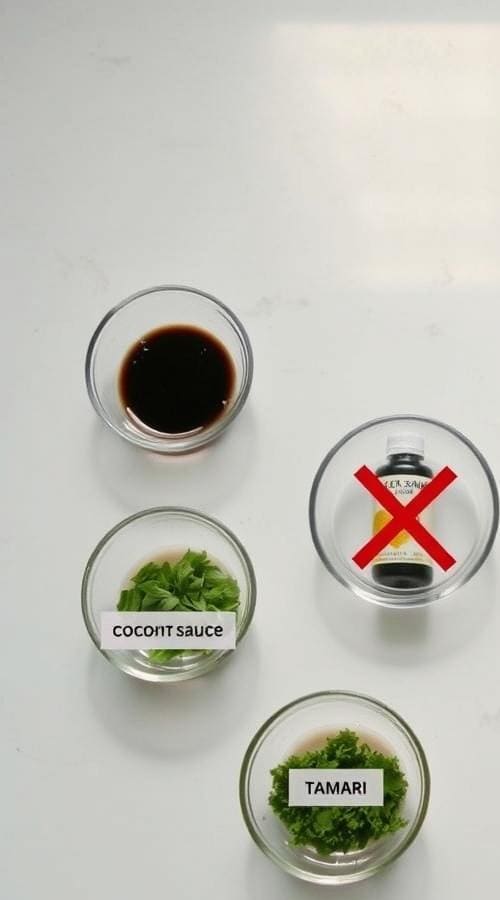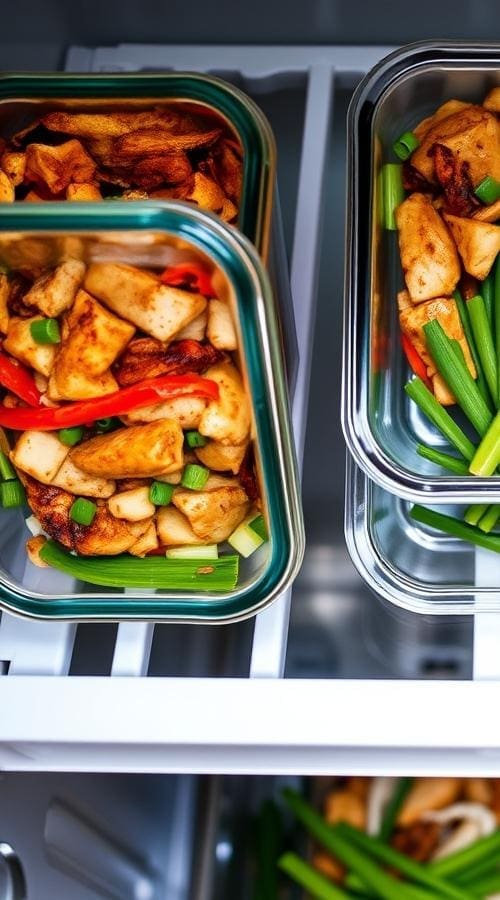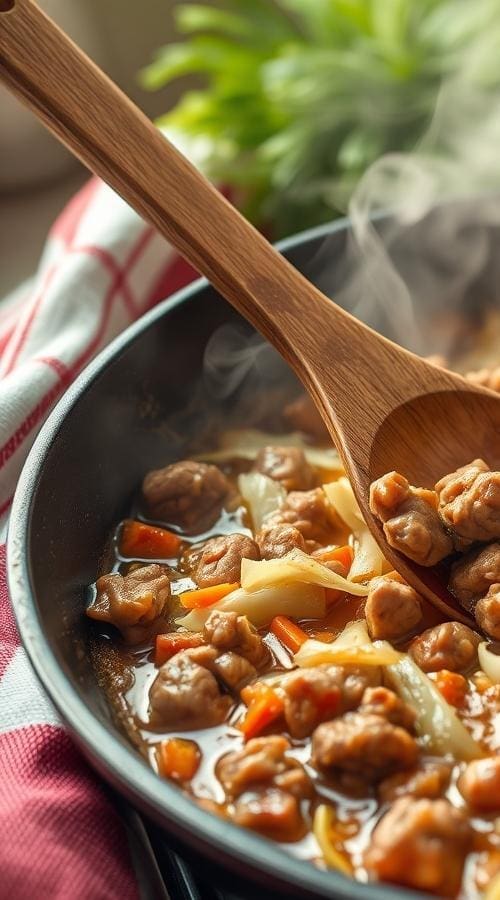Easy Egg Roll in a Bowl Recipe (20 Minutes, One Pan)

If you’re racing against the clock on a Tuesday night but still crave something delicious and nourishing, this egg roll in a bowl recipe is your new best friend. Skipping the hassle of wrapping and frying traditional egg rolls, we pack all the crave-worthy flavors—tender cabbage, savory ground pork, and a zesty ginger-garlic sauce—into a single skillet.
Ready in just 20 minutes, it’s perfect for beginners and busy families alike. As a registered dietitian, I love how this dish balances convenience with nutrition, incorporating veggies for fiber and protein for staying power.
Let’s dive into why this recipe will become your go-to and how to make it your own.
- Why This Egg Roll in a Bowl is Weeknight Gold
- Key Ingredients and Smart Substitutions
- Health Benefits of Key Ingredients
- Step-by-Step Instructions
- Delicious Variation Ideas
- Allergen and Dietary Notes
- How to Store and Reheat Extras
- Serving Suggestions and Pairings
- Nutritional Breakdown
- Common Mistakes and Troubleshooting
- More Quick Dinner Ideas
- Conclusion
Why This Egg Roll in a Bowl is Weeknight Gold

Picture this: It’s 6 PM, the kids are demanding dinner, and you haven’t even unpacked the groceries. That’s where this egg roll in a bowl shines.
Unlike traditional egg rolls that require rolling dough and deep-frying oil, this deconstructed version cooks everything together in one pan, minimizing cleanup to just a quick wipe-down. The bold umami from soy sauce and ginger pairs perfectly with the crunch of cabbage and carrots, creating a meal that’s as satisfying as takeout but far healthier.
Studies from the American Journal of Clinical Nutrition highlight how cabbage, a cruciferous vegetable, supports gut health thanks to its prebiotic fibers. Plus, with options for low-carb swaps like cauliflower rice, it fits various dietary needs without sacrificing taste.
In under 20 minutes, you’ll have a dinner that feels indulgent yet fuels you properly—no drive-thru required.
Key Ingredients and Smart Substitutions

Gathering the ingredients for this egg roll in a bowl is straightforward, relying on pantry staples and easy-to-find produce. Here’s the lineup for four servings:
- 1 lb ground pork (or turkey, beef, or chicken for variety)
- 14 oz bagged coleslaw mix (shredded cabbage and carrots for convenience)
- 1.5 cups additional shredded carrots
- 1 tbsp sesame oil
- 1 small sweet onion, diced
- 4 cloves garlic, minced
- 1 tbsp fresh ginger, minced
- 2 tbsp rice vinegar
- 1/3 cup soy sauce or coconut aminos (lower sodium option)
- 2 large green onions, sliced
- 1 cup cooked white rice (frozen for speed)
- 2 cups cauliflower rice, defrosted
Substitutions keep it flexible: For a vegetarian twist, use crumbled tofu or lentils.
If gluten-free, opt for tamari instead of soy sauce. Sesame oil can be swapped with neutral oil, though it adds authentic nutty depth.
Pre-shredded veggies save time, but fresh works too—just chop finely to ensure even cooking.
Health Benefits of Key Ingredients

This recipe isn’t just tasty—it’s a nutritional powerhouse. Cabbage, the star veggie, is low in calories but high in vitamin C and K, aiding immune function and bone health, as noted by the National Institutes of Health.
Ground pork provides lean protein and B vitamins for energy metabolism. Cauliflower rice offers a low-carb alternative to white rice, boosting fiber intake to promote satiety and digestive regularity—research in the Journal of Nutrition shows such swaps can help manage blood sugar levels.
Ginger and garlic bring anti-inflammatory compounds; a study in Phytotherapy Research confirms ginger’s role in reducing nausea and supporting digestion. Together, these ingredients create a balanced meal with about 438 calories per serving, 34g protein, and 6g fiber, making it ideal for weight management and sustained energy.
Step-by-Step Instructions

Making this egg roll in a bowl is foolproof—follow these steps for success:
- Heat 1 tbsp sesame oil in a large skillet over medium heat. Sauté diced onion, minced garlic, and ginger for 2-3 minutes until fragrant and onions soften.
- Add 1 lb ground pork, breaking it up with a spoon. Cook for 5-7 minutes until browned and fully cooked through, draining excess fat if needed.
- Stir in 14 oz coleslaw mix, 1.5 cups shredded carrots, 2 cups defrosted cauliflower rice, and 1 cup cooked white rice. Cook for 2-3 minutes until veggies begin to wilt but retain some crunch.
- Pour in 2 tbsp rice vinegar and 1/3 cup soy sauce (or coconut aminos). Season with salt and pepper to taste. Simmer for another 2-3 minutes to meld flavors.
- Fold in sliced green onions and cook for 1-2 more minutes. Remove from heat and serve hot, optionally topped with sesame seeds or a fried egg.
Pro tip: Use a wide skillet to avoid overcrowding, ensuring even cooking.
Delicious Variation Ideas

One of the best parts of this recipe is its adaptability. For vegetarians, replace pork with 1 cup edamame and crumbled tempeh for plant-based protein.
Amp up veggies by adding diced bell peppers or snap peas during step 3—they add color and antioxidants. Craving spice?
Drizzle with sriracha or mix in chili flakes. To lower carbs further, omit white rice entirely and double cauliflower rice; this version clocks in under 30g net carbs per serving.
For a gluten-free option, use tamari and ensure your rice vinegar is certified GF. Try it over zucchini noodles for a keto-friendly base, or scramble in an egg at the end for extra richness.
These tweaks keep things fresh while maintaining the 20-minute timeline.
Allergen and Dietary Notes

This recipe is naturally dairy-free and can be adapted for various diets. Common allergens: Soy (in sauce—swap with coconut aminos for soy-free), sesame (oil—use avocado oil alternative), and potential gluten in soy sauce (use tamari).
It’s low-FODMAP if you reduce onion and garlic, suitable for IBS management per Monash University guidelines. For nut-free, it’s already safe, but check labels on packaged items.
Pregnant individuals or those with pork concerns can switch to ground turkey. Always consult a healthcare provider for personalized advice, especially if managing conditions like hypertension due to sodium content (about 1198mg per serving—use low-sodium soy to cut it in half).
How to Store and Reheat Extras

Meal prep is a breeze with this dish. Store leftovers in airtight containers in the fridge for up to 4 days; the flavors even intensify overnight.
For freezing, portion into freezer-safe bags and use within 2 months—thaw overnight in the fridge before reheating. To reheat, microwave in 1-minute bursts stirring midway, or stovetop over low heat with a splash of water to restore moisture.
If it seems dry, a teaspoon of soy sauce revives the savoriness. This makes it perfect for lunchboxes or busy workdays, aligning with USDA recommendations for safe food storage. For more convenient meal ideas, check out our favorite dietitian-approved road trip snacks.
Serving Suggestions and Pairings

Serve this egg roll in a bowl family-style straight from the skillet for a casual vibe, or portion into bowls with chopsticks for fun. Pair with a simple side salad of mixed greens and sesame dressing to boost veggie intake, or steamed edamame for extra protein.
The H. Chan School of Public Health suggests such pairings enhance nutrient absorption.
It’s also great alongside miso soup for an Asian-inspired spread. Kids might enjoy it wrapped in lettuce leaves for a fun, low-carb taco twist.
Nutritional Breakdown

Per serving (1/4 of recipe): 438 calories, 57g carbohydrates (6g fiber, 10g sugar), 34g protein, 8g fat (2g saturated), 75mg cholesterol, 1198mg sodium, 1008mg potassium, plus vitamins A (8242 IU), C (46mg), calcium (110mg), and iron (2mg). This profile supports balanced eating: High protein aids muscle repair, while fiber from veggies promotes heart health, as per the Dietary Guidelines for Americans.
Note: Values are estimates; actual nutrition varies with substitutions. For personalized plans, consult a dietitian.
Common Mistakes and Troubleshooting

Avoid overcooking the cabbage—it should stay tender-crisp, not soggy; add it later if needed. If the sauce is too salty, balance with a squeeze of lime.
For bland flavor, check your ginger and garlic freshness—they’re key. If using frozen rice, ensure it’s fully thawed to prevent watery results.
Pork can stick if the pan’s too hot—medium heat is ideal. These tips come from years of testing in my kitchen, ensuring consistent results even for novice cooks.
More Quick Dinner Ideas

Loving this easy approach? Try our Spicy Chicken Salad for another protein-packed alternative, or the 3 Bean Salad for a no-cook refresh.
For another Asian flair, whip up a Teriyaki Bowl in 15 minutes. These recipes follow the same one-pan philosophy, helping you build a repertoire of fast, healthy meals that keep nutrition front and center.
Conclusion
This egg roll in a bowl isn’t just a recipe—it’s a blueprint for stress-free, flavorful weeknights. With its quick prep, customizable options, and solid nutritional foundation, it empowers you to eat well without the fuss.
As a dietitian, I recommend incorporating it into your rotation for its versatility and health perks. Give it a try tonight and let the compliments roll in!
